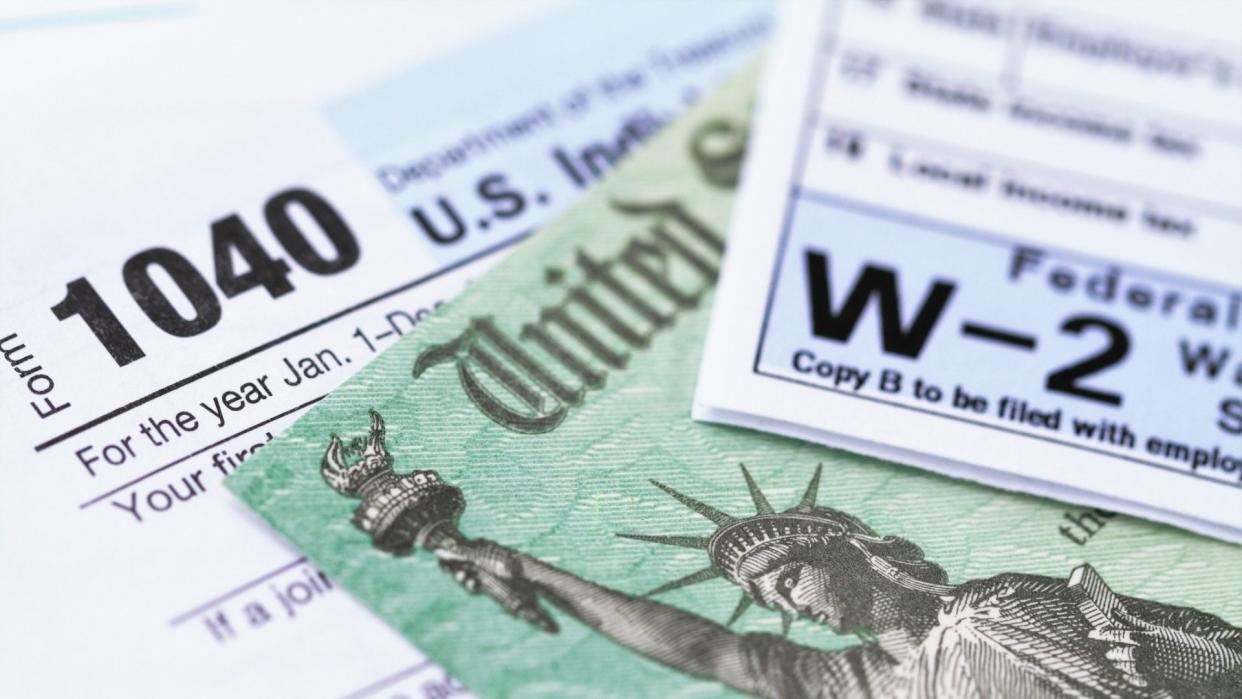Withholding Tax: How It Impacts Your Finances

Everyone loves to gripe about how much they hate paying taxes, yet millions of Americans look forward to tax season every year because of that sweet refund, which the government deposits right into their checking accounts as if it were income that they earned. That’s because it is.
Save: 10 Things To Stop Buying in 2023
Related: 3 Ways Smart People Save Money When Filing Their Taxes
Also: States Whose Economies Are Failing vs. States Whose Economies Are Thriving
Now that the country is settling back into life without pandemic stimulus payments, the tax refund will reclaim its title as the biggest financial windfall of the year for the average American family. That might not necessarily be a good thing — and none of it would be possible without tax withholding.
One Way or the Other, You Pay Your Taxes as You Go
One of the more grueling aspects of self-employment is that independent contractors have to make estimated quarterly income tax payments every three months. If you don’t pay up every quarter, or if you pay too little, you’ll be hit with fines and penalties come tax time.
Millions of W-2 earners who collect a paycheck from an employer don’t have to do anything at all — but America’s income tax system works on a pay-as-you-go basis for them, too.
To keep revenue flowing in steadily — and to avoid having to wring unpayable payments out of millions of people at the same time every year — the IRS taxes income at its source before the masses can turn it into Amazon merch.
It’s called tax withholding, and the process requires nearly all employers to siphon off a portion of nearly every employee’s check every single pay period. The employer then hands the money over to the IRS on the employee’s behalf as a credit toward that employee’s income tax obligations.
Take Our Poll: How Big of a Sign-Up Bonus Would It Take for You To Change Banks?
A Refund Is the IRS’ Way of Saying ‘Thanks for the Loan’
If your employer withholds too little, the IRS will hit you with a bill for the outstanding amount. If your employer withholds too much, the IRS will issue a refund for the difference — but none of this happens until the following year’s tax season.
In the meantime, the IRS uses your tax withholdings to pay its bills and maintain its operations before paying you back. Every extra dollar your employer withholds from your check is a dollar that you loan to the IRS involuntarily at a rate of 0% interest.
If you fail to pay your own taxes on time, you should expect no such generosity from the IRS. When the money goes the other way, they charge you the federal short-term interest rate plus 3%.
A Refund Is Great — Or Is It?
The IRS almost always errs on the side of caution, collecting what you’re likely to owe and then some. By the end of February last year, the IRS had issued more than 22 million tax refunds for tax year 2021. The average early bird received a refund of $3,536, which was more than $700 higher than 2020’s average payment of $2,815, according to CNBC.
Big, juicy lump-sum direct deposits like that are always nice, but consider the things that you weren’t doing with that $3,536 while the IRS was skimming it from every single paycheck you earned last year:
Watching it earn compound interest in an emergency savings account
Watching it grow in a brokerage account — the S&P 500 gained almost 27% in 2021, which would have turned your $3,536 into $4,490.72 for gains of nearly $1,000
Watching it increase in value in a tax-advantaged retirement fund like an IRA or Roth IRA
Increasing the value of your home by using it for repairs
Using it to launch a side hustle
Putting it into your child’s college fund, where its gains could have compounded
Using it to pay down debt
How Do I Adjust My Withholdings?
If you’re beginning to view your tax refund not as a windfall, but as money that the IRS borrowed from you without paying interest, you’re on the right track. So, how do you scale back those withholdings?
Start by gathering your relevant documents — your most recent tax returns, pay statements for yourself and your spouse (if applicable) and information about other income sources — and use the Tax Withholding Estimator tool on IRS.gov. The IRS recommends using the estimator as early in the year as possible, as well as after major life changes like the birth of a child, the purchase of a home or a marriage.
Visit the IRS’ Paycheck Checkup page for more information about who should use the estimator and when. Depending on the results, you’ll want to fill out a new Form W-4 and give it to your employer. Just remember, if you swing too far the other way and ask your employer to withhold too little, you’ll get a bill from the IRS right around the same time of year that you had gotten used to receiving a refund.
More From GOBankingRates
Target, Amazon and 4 More Retailers That Will Reward You for Turning in Your Old Stuff
Write Off Your Mileage? The IRS Expands the Deduction for Fuel Costs in 2023
This article originally appeared on GOBankingRates.com: Withholding Tax: How It Impacts Your Finances
